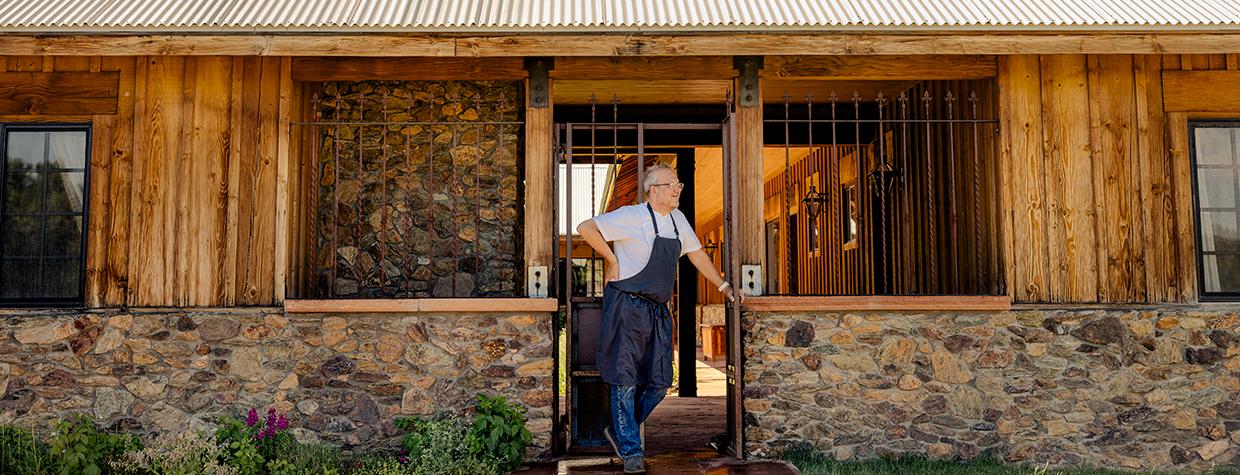As we drive past a metal gate and make our way up a rugged dirt road, acclaimed chef James Porter (pictured) can hardly contain himself — he’s anxious to share his special place in Central Arizona. Applying the brakes, he pauses to survey the sweeping high-desert landscape in the distance.
“This is what I love about this place,” he says as he maneuvers the vehicle to a spot with the best view. “So many times driving in here, I don’t pay attention to what’s going on. But sometimes, I just like to stop and look at the beauty of what’s out here. This is pretty remarkable. You don’t get this in Scottsdale.”
Soon, as we drive over the hill, Terra Farm and Manor comes into view. It’s a well-appointed, rustic-looking lodge that Porter envisions as a destination for people looking to escape the crush of everyday life to stay, relax, mingle and immerse themselves in a culinary experience unmatched in the American Southwest. On tap are cooking classes with ingredients foraged from Terra’s gardens. Multicourse meals are prepared with beef, pork and lamb raised there. Wine and perhaps a good cigar are on the menu, too.
And high on the list are hopes that Porter’s all-inclusive, farm-to-table project, tucked into the Prescott National Forest, will open some eyes along the way. “It’s my off-the-grid homage to the ‘grow it, raise it, eat it’ sort of mentality,” says Porter, an industry veteran who’s run two popular Scottsdale restaurants. “It’s not just about the journey of food; it’s also about the experience of seeing things and understanding them. That’s the journey I want to take you on.”
Eight guest rooms adorned with Western decor and furnishings are available, with occupancy capped at 16. A leather-bound book in each room offers a glimpse of the property’s history since it was homesteaded in 1914. And once guests arrive, there are no decisions to make — other than about dietary restrictions — during their four-day, three-night stay. Their itinerary has already been mapped out, right down to their favorite after-dinner libation.
Nearby is a game room and a library containing Louis L’Amour offerings and vintage Arizona Highways magazines. The lodge is well appointed with Arizona touches, from local flagstone at its entrance to the iron chandelier and other works forged by a local craftsman. A bison head hangs above a large fireplace.
At the heart of Terra is the culinary studio and courtyard, displaying an array of cooking devices such as an antique stove from France. Inside, guests can absorb knowledge from Porter and visiting high-profile chefs brought in to share their techniques and offer tips and tricks of the trade. Nothing too complicated, though. “No one wants to stand on their feet for more than two hours to learn in a cooking class,” Porter says. “We try to say, ‘Here’s the best technique, best ingredients to use and how to get the best outcome.’ ”
Attendees might even pull some of the ingredients out of the ground themselves. “We may be in a cooking class, and I may say, ‘OK, everybody, grab your bowls and scissors,’ ” Porter says. “You pick it, and we cook with it. It’s a little bit like a Disney World.” And winemakers also are part of the agenda, with such cult wineries as Hundred Acre, of Napa Valley, among the visiting talent.
Terra was born about nine years ago, when Porter was approached by a former customer and family business associate who owned the largely undeveloped property and wanted to do something with it. The two agreed that turning the 100 acres into a stunning example of agritourism done right was the way forward, and Porter returned to Arizona from a consulting stint in Wisconsin to make it happen. Bits and pieces of inspiration came from such resorts as Blackberry Farm in Tennessee, Blue Hill Farm in New York, The Resort at Paws Up in Montana and Brush Creek Ranch in Wyoming.
About four years ago, Terra opened to guests with an emphasis on Arizona and a fixation on the best of the best in culinary terms. The showpieces are the animals raised on the surrounding 200,000-acre ranch, heritage breeds including Tajima Wagyu beef, Ibérico pigs and Icelandic sheep. Several of each are brought near the lodge for guests to see, and if the timing is right, a baby lamb might be available to pet. Roughly 50 percent of the vegetables needed are grown on-site, too.
Sitting on the porch on a recent blue-sky day, Porter says guests seem to be taking a liking to his grand experiment in the pines. “When people leave, there is a sense of connectivity between them,” he says. “I don’t know how to explain it. But it’s authentic, and it’s genuine. Yeah, this place is special.”

